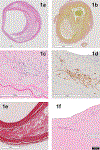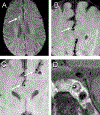Epidemiology, Pathophysiology, and Imaging of Atherosclerotic Intracranial Disease
- PMID: 38252756
- PMCID: PMC10827355
- DOI: 10.1161/STROKEAHA.123.043630
Epidemiology, Pathophysiology, and Imaging of Atherosclerotic Intracranial Disease
Abstract
Intracranial atherosclerotic disease (ICAD) is one of the most common causes of stroke worldwide. Among people with stroke, those of East Asia descent and non-White populations in the United States have a higher burden of ICAD-related stroke compared with Whites of European descent. Disparities in the prevalence of asymptomatic ICAD are less marked than with symptomatic ICAD. In addition to stroke, ICAD increases the risk of dementia and cognitive decline, magnifying ICAD societal burden. The risk of stroke recurrence among patients with ICAD-related stroke is the highest among those with confirmed stroke and stenosis ≥70%. In fact, the 1-year recurrent stroke rate of >20% among those with stenosis >70% is one of the highest rates among common causes of stroke. The mechanisms by which ICAD causes stroke include plaque rupture with in situ thrombosis and occlusion or artery-to-artery embolization, hemodynamic injury, and branch occlusive disease. The risk of stroke recurrence varies by the presumed underlying mechanism of stroke, but whether techniques such as quantitative magnetic resonance angiography, computed tomographic angiography, magnetic resonance perfusion, or transcranial Doppler can help with risk stratification beyond the degree of stenosis is less clear. The diagnosis of ICAD is heavily reliant on lumen-based studies, such as computed tomographic angiography, magnetic resonance angiography, or digital subtraction angiography, but newer technologies, such as high-resolution vessel wall magnetic resonance imaging, can help distinguish ICAD from stenosing arteriopathies.
Keywords: arteries; cerebral infarction; demography; intracranial arteriosclerosis; stroke.
Conflict of interest statement
Figures




References
-
- Gorelick PB, Wong KS, Bae H-J and Pandey DKJS. Large artery intracranial occlusive disease: a large worldwide burden but a relatively neglected frontier. 2008;39:2396–2399. - PubMed
-
- White H, Boden-Albala B, Wang C, Elkind MS, Rundek T, Wright CB and Sacco RLJC. Ischemic stroke subtype incidence among whites, blacks, and Hispanics: the Northern Manhattan Study. 2005;111:1327–1331. - PubMed
-
- Sharma VK, Tsivgoulis G, Teoh HL, Ong BK, Chan BPJJoS and Diseases C. Stroke risk factors and outcomes among various Asian ethnic groups in Singapore. 2012;21:299–304. - PubMed
-
- Tsivgoulis G, Vadikolias K, Heliopoulos I, Katsibari C, Voumvourakis K, Tsakaldimi S, Boutati E, Vasdekis SN, Athanasiadis D and Al-Attas OSJJoN. Prevalence of symptomatic intracranial atherosclerosis in Caucasians: a prospective, multicenter, transcranial Doppler study. 2014;24:11–17. - PubMed
-
- Mazighi M, Labreuche J, Gongora-Rivera F, Duyckaerts C, Hauw J-J and Amarenco PJS. Autopsy prevalence of intracranial atherosclerosis in patients with fatal stroke. 2008;39:1142–1147. - PubMed
Publication types
MeSH terms
Grants and funding
LinkOut - more resources
Full Text Sources
Medical

